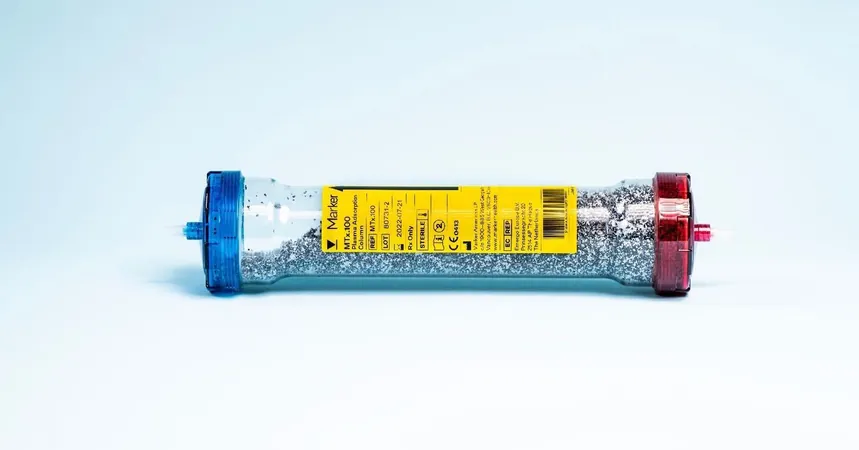
Revolutionary Startup Claims to Detoxify Your Blood from Microplastics!
2025-04-02
Author: Wei
Introduction
In an astonishing world where microplastics have infiltrated even the most remote corners of our planet—from the peak of Mount Everest to the depths of the Mariana Trench—concerns over their presence in human bodies are escalating. Microplastics have been discovered in everything from human placentas to breast milk, and now there’s a startup claiming it can cleanse these contaminants from your blood.
The Controversial Treatment at Clarify Clinics
Clarify Clinics, located in the upscale area of Harley Street, London, offers a controversial treatment designed to rid your blood of microplastics, harmful chemicals, and toxins. For a staggering price starting at £9,750 ($12,636), patients receive a two-hour procedure that removes blood, filters it through a mechanism intended to capture microplastics, and then returns the cleansed plasma back to the body.
“Once it's running, you feel nothing. It's very comfortable,” says Yael Cohen, CEO of Clarify Clinic. Patients often engage in calls or even sleep during the process, seeking relief from myriad symptoms—from chronic fatigue to brain fog linked to conditions such as long Covid. Interestingly, many clients seeking these treatments are also those using Ozempic-style weight-loss drugs or those aiming to improve fertility or stave off dementia.
Scientific Consensus and Health Risks
However, amidst rising interest, scientific consensus on the impact of microplastics on human health remains murky. A 2022 report from the World Health Organization (WHO) stated the necessity of further research to establish if microplastics pose a risk to human health. While recent studies have linked microplastics to potential harm, such as an elevated risk of heart attacks observed in people with microplastics in their arteries, no definitive causal relationships have been established yet.
Frederic Béen, an environmental contaminants researcher, emphasizes, “The dose makes the poison,” underlining the importance of accurately measuring human exposure to any environmental contaminant. This complexity continues to challenge efforts to quantify the potential health risks associated with microplastics.
Challenges in Microplastic Analysis
Furthermore, collecting accurate blood samples for microplastic analysis is no simple task—cross-contamination is a constant threat due to the pervasiveness of plastics in our environment. Researchers go to considerable lengths to maintain purity during analysis, utilizing plastic-free equipment and filtered air in labs.
Patient Experiences and Observations
Many patients at Clarify claim to feel improved energy levels or better sleep quality after their treatment, with some documenting their blood microplastic test results on social media platforms. This burgeoning trend of “blood cleansing” mirrors other high-cost, evidence-light health treatments targeting affluent individuals, including experimental therapies like stem cell injections and total plasma exchanges.
When Blood Cleansing is Justified
It’s essential to note that in extreme cases of pollutant exposure, such as events reported earlier this year in Jersey where bloodletting was recommended after exposure to PFAS chemicals, some form of blood cleansing may be warranted. PFAS exposure has been linked with severe health issues, including certain cancers.
Conclusion
As for the average individual's blood microplastic load—many still remain in the dark. My own fingertip blood test revealed approximately 190 microplastic particles per milliliter, a figure that Cohen humorously noted translates into nearly one million particles circulating within my system.
With such staggering numbers at stake, are blood cleanses truly the answer, or simply a luxurious wellness trend? As we continue to navigate the complexities of environmental health, one thing remains certain: our modern world is in dire need of solutions to combat the plastic crisis that surrounds us. Would you be willing to pay thousands for a potentially unproven treatment? The debate rages on!



 Brasil (PT)
Brasil (PT)
 Canada (EN)
Canada (EN)
 Chile (ES)
Chile (ES)
 Česko (CS)
Česko (CS)
 대한민국 (KO)
대한민국 (KO)
 España (ES)
España (ES)
 France (FR)
France (FR)
 Hong Kong (EN)
Hong Kong (EN)
 Italia (IT)
Italia (IT)
 日本 (JA)
日本 (JA)
 Magyarország (HU)
Magyarország (HU)
 Norge (NO)
Norge (NO)
 Polska (PL)
Polska (PL)
 Schweiz (DE)
Schweiz (DE)
 Singapore (EN)
Singapore (EN)
 Sverige (SV)
Sverige (SV)
 Suomi (FI)
Suomi (FI)
 Türkiye (TR)
Türkiye (TR)
 الإمارات العربية المتحدة (AR)
الإمارات العربية المتحدة (AR)